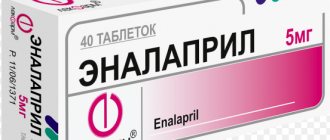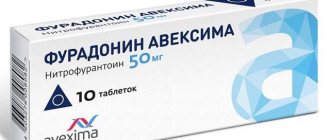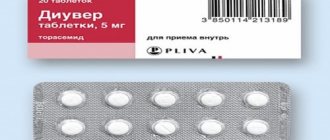Why is Curantil prescribed during pregnancy?
During the period of bearing a child, the female body experiences enormous stress. All organs and systems do more work than before, for example, the heart begins to pump a larger volume of blood than before pregnancy.
Curantil 25 during pregnancy has a beneficial effect on the cardiovascular system, in particular:
- prevents the appearance of cholesterol plaques;
- strengthens the walls of blood vessels;
- thins the blood;
- improves blood circulation.
The drug is prescribed to prevent placental insufficiency. In the presence of this disease, the placenta simply ceases to perform its functions, for example, it does not supply the fetus with oxygen or nourish it. Taking Curantil during pregnancy can prevent this condition by improving blood microcirculation in the placenta. Read more about placental insufficiency →
The drug does not pose a danger to the baby, since it affects the blood vessels that are located in the placenta itself, that is, the active substance does not penetrate the child’s body.
In addition to restoring the functioning of the placenta, taking Curantil during pregnancy helps solve the problem of hemorrhoids, which is relevant for many expectant mothers. Also, thanks to the normalization of blood pressure, the functioning of other organs that perform double duty, such as the kidneys, improves.
The active ingredient in Curantil is dipyridamole; it promotes the production of interferons, which is an excellent support for the immune system, which is significantly weakened during pregnancy. Taking the drug in this case brings more benefit than harm. The consequences of viral diseases can be more serious.
Curantil is prescribed during pregnancy and to solve other problems, namely:
- high blood pressure;
- convulsions;
- late toxicosis;
- swelling.
Despite the positive effect on the mother’s body and safety for the baby, only a doctor can prescribe the drug. It is he who will select the required dosage and tell you how to take Curantil during pregnancy.
Pharmacological action of Curantil
In accordance with the instructions for Curantil, the active ingredient of the drug in all forms of release is dipyridamole. The excipients included in the Curantil 25 dragee are lactose monohydrate, gelatin, potato starch, magnesium stearate, sucrose, talc, calcium carbonate, macrogol 6000, light basic magnesium carbonate, glucose syrup, carnauba wax, titanium dioxide, polyvidone K 25, dye. Auxiliary components of Curantil tablets are corn starch, lactose monohydrate, sodium carboxymethyl starch (type A), gelatin, magnesium stearate, colloidal anhydrous silicon dioxide. The film shell contains talc, hypromellose, macrogol 6000, dye, titanium dioxide, simethicone emulsion.
When used, Curantil promotes dilation of coronary vessels, an increase in the volumetric velocity of blood flow, an increase in the oxygen content in the venous blood of the coronary sinus and its absorption by the myocardium.
The instructions for Curantil note that the substance activates collateral coronary circulation, reduces the manifestations of acute hepatorenal syndrome, has an angioprotective effect, and improves the microcirculation process. The properties of the drug are due to an increase in the activity of endogenous adenosine by reducing its uptake by tissues and destruction.
Curantil is an antagonist of the endogenous adenosine diphosphate aggregant, inhibits phosphodiesterase, due to which the process of release of aggregation activators from platelets (serotonin, thromboxane, adenosine diphosphate) is blunted and platelet aggregation is eliminated.
The use of Curantil as an antiplatelet drug in combination with acetylsalicylic acid is effective. In a dose-dependent manner, the drug prolongs the pathologically shortened lifespan of platelets.
Curantil dilates the coronary arteries and causes the phenomenon of intercoronary steal. The drug has a modulating effect on the interferon system and increases the body's antiviral resistance to viral infections.
The medication improves venous outflow, reduces the incidence of thrombosis in the postoperative period, and normalizes the process of microcirculation in the renal glomeruli and retina of the eyes. Curantil is effectively used to treat cerebral circulatory disorders and reduce cerebral vascular tone.
During pregnancy, Curantil prevents blockage of blood vessels in the placenta, thereby preventing the occurrence of fetal hypoxia.
Indications and contraindications
When your doctor prescribes you to take the drug, you need to ask him why you should take Curantil during pregnancy. Indications may be the following:
- impaired blood circulation in the placenta (the drug can also be prescribed to prevent such a condition);
- fetal hypoxia;
- increased platelet count;
- weakened immunity during periods of increased risk of viral diseases;
- impaired blood clotting;
- insufficient blood flow into the capillaries;
- high blood pressure;
- the presence of thrombosis (in this case it is prescribed to prevent their occurrence).
In most cases, the use of Curantil tablets during pregnancy is carried out for prophylactic purposes. This means that in order to prescribe it, the doctor must be sure that the development of a certain disease is inevitable in the absence of preventive measures.
As a rule, it is used in courses throughout the entire gestation period. Curantil is prescribed in the first trimester of pregnancy to prevent fetoplacental insufficiency. This condition is characterized by disorders of the placenta and fetus due to various diseases and obstetric complications.
Curantil n 25 helps to normalize blood circulation between the expectant mother and the child, which results in the restoration of normal nutrition and oxygen supply. In the early stages of pregnancy, chimes can provoke bleeding, which can be avoided by choosing the right dosage, as well as following a special diet.
It is recommended to remove foods that thin the blood from your diet. These are vegetables (cucumbers, tomatoes, onions, garlic), citrus fruits, berries, natural juices, fish and fish oil.
Curantil in late pregnancy is prescribed if the patient has gestosis, which is the result of blood thickening. In this condition, the supply of oxygen to organs is disrupted, which leads to malfunctions in their functioning. Read more about the signs and treatment of gestosis →
Externally, this condition manifests itself as excessive swelling in the arms, legs, abdomen, and face. Chimes normalize blood circulation, and therefore eliminate the symptoms of late toxicosis. In addition, the child’s condition is also affected - during the active development of organs, it is necessary for the expectant mother to feel good in order to provide adequate nutrition to the baby.
Immediately before childbirth, Curantil helps to cope with prenatal swelling. However, two weeks before the expected date of birth, the drug must be stopped.
Despite the peculiarities of the drug’s effect on the mother’s body and its safety for the baby, there are also contraindications to taking Curantil:
- low blood pressure - the drug can reduce it even further due to vasodilation, which can result in a critical condition;
- liver failure - the active substance is transformed in liver cells, which means it affects the functioning of the organ;
- heart failure - dipyridamole tends to accumulate in the heart muscle;
- diseases that increase the risk of bleeding, such as stomach ulcers;
- renal failure, its chronic form;
- hypersensitivity to the components of the drug, tendency to allergies.
In addition, the presence of any disease may be a contraindication to taking the drug. This is explained by the fact that the active substance can accumulate in red blood cells and spread throughout the body, and therefore affect any weakened organ.
Indications for use of Curantyl
In accordance with the instructions for Curantil, the drug is prescribed to people for the treatment of dyscirculatory encephalopathy and ischemic cerebral circulatory disorders. The medicine is recommended for the prevention and treatment of influenza and acute respiratory viral diseases.
The use of Curantil as part of complex therapy for microcirculation disorders of various etiologies is effective.
Reviews of Curantil report the effectiveness of taking the drug for the prevention of coronary heart disease, venous and arterial thrombosis, and thromboembolism after heart valve replacement surgery.
During pregnancy, Curantil is recommended for the prevention of placental insufficiency.
Dosage and method of administration
The instructions for use of Curantil during pregnancy indicate the standard rules of administration, but the exact dosage is always selected individually.
If you are prescribed Curantil during pregnancy, your doctor will decide how and how much to take the drug. It takes into account the following factors:
- gestational age;
- indications based on which the decision to prescribe the drug was made;
- test results.
This is why it is not recommended to prescribe this drug to yourself, even if you already took it in the early stages of pregnancy. This can harm you and your unborn baby.
As a rule, the regimen for taking Curantil n 25 during pregnancy is as follows: 1 tablet, which corresponds to 25 ml of dipyridamole, is taken three times a day. If necessary, the doctor may decide to increase the dose to 75 ml in one or two doses per day. In such cases, drinking Curantil 75 during pregnancy is more convenient.
The drug should be taken one hour before meals or 2 hours after meals at the same time.
If taking Curantil does not lead to the desired result, you must consult a doctor to correct the treatment regimen. You cannot do this on your own.
It is also necessary to follow the rules for taking Curantyl:
- You should not combine the drug with tea and coffee, as these drinks may reduce the effectiveness of the drug. To take the tablet, it is better to take clean water.
- The product should be taken on an empty stomach, an hour before meals or 2 hours after meals.
- The tablet must not be chewed, bitten or otherwise crushed.
In emergency cases, the drug is administered intravenously. The effect of this form of Curantil is similar to tablets, but the effect lasts a short period of time.
Curantil tablets: facts about taking them
Curantil tablets are prescribed to improve blood flow, as well as raise the placenta. The duration of the appointment depends both on the doctor’s prescription and on the woman’s well-being. In second place after Curantil is its analog Dipyridamole. Dipyridamole and aspirin in combination are primarily drugs that prevent heart attacks and strokes. Complaints from some women after some time while taking Curantil say that one of its side effects is bleeding, which can cause an overdose.
A few facts about taking chimes:
- If your stomach hurts during a week of taking Curantyl, you should consult a doctor and most likely stop taking it;
- Curantil is a very effective medicine for hemorrhoids;
- Curantil and boron uterus contribute to good treatment of hyperplasia;
- To maintain pregnancy, Curantil and Iodomarin are prescribed;
The pregnancy hormone progesterone thickens the blood, and Curantil thins it.
Side effects
Any drug may have different effects than expected. Many factors contribute to this, for example, the condition of a particular organ. That is why the doctor should warn about possible negative consequences.
If a woman takes Curantil during pregnancy, side effects may affect the functioning of a number of organs, namely:
- gastrointestinal tract - vomiting, diarrhea, nausea;
- cardiovascular system - decreased blood pressure, hot flashes, heart rhythm disturbances, subject to increased recommended doses;
- nervous system - dizziness and headache;
- skin - urticaria, rash.
Among other negative reactions, joint pain and increased bleeding during medical procedures are observed. It is in the presence of a large list of contraindications and side effects that the main disadvantage of Curantil is revealed. We also must not forget that shortly before giving birth, the drug should be stopped, since the risk of bleeding increases.
How to get rid of the problem yourself?
When faced with swelling during pregnancy, doctors recommend that women make every effort to eliminate the problem with non-drug treatment. To do this, they recommend using the following tips. In most cases, this really helps to get rid of edema in late pregnancy:
- Eliminate physical activity and long walks, especially in hot weather.
- At the end of the day, take a relaxing foot bath, which requires water at room temperature and sea salt. After a relaxing bath, a massage will help relieve tired legs.
- It is necessary to review the diet and minimize foods that contain large amounts of salt and spices. Fatty and spicy foods also have no place in the diet of an expectant mother facing edema.
- If possible, a woman should drink small amounts of fluid throughout the day.
- To prevent your feet from getting so tired and swelling during pregnancy, you should forget about shoes with wedges and heels. The best option is comfortable ballet flats and moccasins made from natural material.
In most cases, these recommendations help with swelling. At the same time, their manifestation is significantly reduced, and the woman feels relief.
Interaction with other drugs and analogues
During pregnancy, a woman needs to be extremely careful when taking various medications. This also applies to Kurantil. It is not only not recommended to combine it with some medications, but even prohibited. For example, it is strictly contraindicated to take Curantil and Aspirin at the same time (the second drug should not be used during pregnancy in any case).
This drug also affects drugs that lower blood pressure. It enhances the effect of these medications, which can result in a sharp drop in blood pressure, which is extremely undesirable during pregnancy.
Unfortunately, there are no analogues of the drug, either in composition or in its effect. Therefore, when Curantil is needed during pregnancy, the dosage is adjusted and the decision on its use is made based on the benefit-risk ratio.
If an appointment is not possible at all due to contraindications, the doctor selects other means, depending on the treatment goals. Replacement options:
- To thin the blood during pregnancy, Actovegin can be prescribed, which is as close in action as Curantil, but differs in its mechanism of action. Sometimes during pregnancy Actovegin and Curantil are combined.
- Oscillococcinum is recommended to enhance immunity.
Curantil can be called a universal remedy that can prevent fetal hypoxia due to thickening of maternal blood. It thins the blood, makes it move faster, does not stagnate in one place, and therefore avoids swelling. In this case, the child receives the amount of oxygen and nutrition he needs.
But, despite this, it is impossible to call the drug a harmless vitamin. It is unacceptable to decide on its use on your own. Only with the correct dosage and medical supervision is it safe for the expectant mother and her baby.
Author: Anastasia Mikitalo, doctor specially for Mama66.ru
Properties of the drug
Curantil (international name "Dipyridamole") is a drug that prolongs the life of platelets by stopping them from sticking together. During pregnancy, it is prescribed to prevent the development of problems with oxygen saturation of the placenta. This is a pathology, otherwise known as placental insufficiency, in which the placenta stops fulfilling its direct duties. Problems arise in supplying the embryo with oxygen and nutrients.
How medicine can help in this case:
- Improves blood circulation in the mother's body.
- Fights hypoxia or lack of oxygen in the tissues and organs of the fetus.
- Prevents delayed development of the child and placental abruption.
- Thins the blood, preventing blood clots from forming.
- It is an excellent prophylactic for the mother against varicose veins and hemorrhoids.
- Lowers blood pressure, strengthens blood vessels.
- Helps normalize kidney function.
- Strengthens the immune system by accelerating the formation of interferons. These are cells that are involved in the fight against viruses. They reduce the risk of getting the flu or ARVI.
- Used as a prophylactic against hypertension, late-stage toxicosis and severe edema.
The undoubted advantages include the low price - about 200 rubles for a package of 25 tablets.
This drug is absolutely harmless to the fetus. It “works” with the placenta, or rather, with its vessels. And she, in turn, protects the child from the effects of drugs and infections.
Instructions for use
Only a specialist can prescribe the exact dosage and how much Curantil to drink, based on the week of pregnancy, test results and indications for which the use of the medicine was recommended.
The instructions for use indicate the standard dosage:
- Curantil n25 - one tablet three times a day.
- Curantil n75 - 1-2 tablets per day.
The tablets should be taken one hour before meals or two hours after meals at the same time.
If the required result is not achieved while taking the drug, you should inform your doctor about this to adjust the therapy. Taking analogues or other medications without a doctor's permission is strictly prohibited.
A couple more recommendations:
- You should not take the tablets with tea or coffee, as this reduces the effectiveness of the medication. The tablet should be taken with clean water.
- The tablet should be taken on an empty stomach - an hour before a meal or 2 hours after it.
- Do not crush, bite or chew the tablet.
In emergency cases, Curantil is administered intravenously. The effect of this form is similar to that of the tablet form, but the effect lasts less time.
Curantil is often prescribed together with Actovegin
If, according to indications, the patient is prohibited from taking Curantil, it is necessary to pay attention to its analogues, which also have an anticoagulant and antiplatelet effect. Here they are:
- Aspirin cardio;
- Aspicor;
- Actovegin;
- Cardiomagnyl;
- Thromboass;
- Chophytol;
- Phlebodia;
- Plagril;
- Brilinta et al.
Only a doctor can tell you which of these drugs are allowed during pregnancy. Independent replacement of Curantil with other medications is prohibited.
In some cases, a combination of medications may be prescribed, for example, Curantil and Actovegin (promotes blood thinning). Taking Oscillococcinum will help strengthen your immune system.
Contraindications to the use of the drug
The drug is not prescribed to patients with the following conditions:
- Intolerance to the main active ingredient Curantil.
- The presence of severe hypotension (low blood pressure).
- For idiopathic cardiac hypertrophy and acute ischemic disease.
- In the presence of acute renal or liver failure.
- Previously diagnosed bleeding of unknown etiology.
Curantil is not prescribed to patients with lactose intolerance and hypersensitivity to glucose.
The drug is not recommended for the treatment of children under 10 years of age, since there is currently no data regarding the safety of the drug in pediatrics.
In addition, Curantil is not recommended for use by patients whose work involves controlling complex mechanisms. This limitation is associated with a possible risk of developing hypotension during treatment with the drug.
Interaction
Taking any medication during pregnancy can lead to dire consequences. That is why you should only take medications prescribed by your doctor.
It is strictly forbidden to combine the use of Curantil with acetylsalicylic acid (these tablets are generally prohibited for pregnant women).
The downside of the drug is its effect on medications that lower blood pressure. It increases the effect of these medications, resulting in a sharp drop in blood pressure, which is extremely undesirable during pregnancy.
If you are taking a certain medication and have been prescribed Curantil, be sure to inform your doctor about this to avoid unpleasant consequences.
What else do you need to know about interaction? Joint use of Curantil with:
- antibacterial drugs of the cephalosporin series (Cefazolin, Ceftriaxone) enhances the antiplatelet effect;
- anticoagulants (warfarin, heparin, etc.) and acetylsalicylic acid increases the antithrombotic effect, as a result of which the likelihood of bleeding increases;
- antihypertensive drugs (captopril, nifedipine) leads to a sharp drop in blood pressure.
It is difficult to live without some medications during pregnancy. One such remedy is Curantil. It helps cope with edema, improves the functioning of the cardiovascular system and can be used as a prophylactic against placental insufficiency.
You can take any pills and medications during pregnancy only after they have been prescribed by a doctor. Taking Curantil in the 1st, 2nd and 3rd trimesters helps improve the functioning of the entire body of the expectant mother. But at the same time, if side effects occur, you should immediately stop taking the drug.
Victoria, 23 years old
I took Curantil in the 2nd trimester, as slight swelling appeared. I noticed the first improvements on the 7th day of taking the medicine, the swelling began to gradually subside, and my health began to improve.
I took Curantil in the 3rd trimester. Afterwards I had a severe headache and started bleeding. I had to stay in the hospital for 2 weeks for conservation.
Despite the undoubted benefits of using Curantil, in certain cases it can cause harm. Do not self-medicate and strictly follow the specialist’s recommendations and then pregnancy will be easy!











